| Back to Back Issues Page |
 |
|
Bangkok Travelbug May11 – A Thai wedding in Khemmarat April 28, 2011 |
| Hello
Overview of Ubon Ratchathani Ubon Ratchathani, or Ubon for short, is a province on the eastern borders of Thailand. It has a long border with Laos on the east and to the south, a short stretch with Cambodia. The province is huge; it’s 205 km from north to south and 122 km from east to west at its broadest part. It’s one of the 20 provinces¹ that make up Issarn or north-eastern Thailand. In terms of land area Ubon is second only to Nakhon Ratchasima or Korat. Khemmarat is the northern-most district in Ubon. Khemmarat town is 110 km by road from Ubon city the provincial capital and a little over 600 km from Bangkok. This gives an idea of the distances involved. Footnote ¹ Neighbouring province Amnat Charoen used to be part of Ubon province until it was made a separate province in 1993. In the same year Nong Bua Lam Phu, a former district in Udon Thani became the 76th province in Thailand or the 19th province in Issarn. In August 2010, the Thai Cabinet approved the creation of the 77th Thai province, Bueng Kan formed from eight districts in eastern Nong Khai province. This brings the number of provinces in Issarn to 20. Table of contents History of Ubon Ratchathani Ubon Ratchathani has been in existence for a long time. It was part of Lan Xang (Million Elephants), a kingdom established in 1353 with its centre in Luang Prabang in present day Laos. The kingdom covered vast stretches of the Mekong valley including Vientiane (Laos), Nakhon Phanom (Thailand), Ubon and Champassak (Laos). In 1563 the capital moved to Vientiane for greater security owing to the threat of Burma from the west. Over the centuries, succession conflicts caused the kingdom to break up into three rival city kingdoms, Champassak, Luang Prabang and Vientiane. In the reign of King Taksin (1767 – 1782), the three Lao kingdoms were attacked and brought under Siamese suzerainty in order to secure the eastern borders of Siam. In the reign of King Rama I (1782 – 1809), the Siamese kingdom stretched to Champassak, Vientiane and Luang Prabang. Ubon had the status of a muang (an area consisting of a main town and a group of villages) paying tribute to and under the protection of Bangkok. During the reign of King Rama III (1824 – 1851), constant court power struggles within the Lao kingdoms, led to Siamese intervention. Rulers sympathetic to Siam were installed to pre-empt the Vietnamese from installing their protégés. To overcome the problem of defending the distant provinces on the far bank of the Mekong, large numbers of the Lao² population were resettled in north-eastern Thailand in the Korat plateau³. In addition, 40 new muang were created, Khemmarat was one of them, putting it on par with Ubon. It was only in the 20th C that Khemmarat reverted to a district in Ubon. Footnote ² In the Lao and Thai languages, the word Lao refers to the country, the people, the nationality and the language. ³ For this reason, the people in north-eastern Thailand speak a dialect very similar to Lao. Ethnically and culturally they are also akin to the Lao people. Table of contents The Wedding in Khemmarat It was still dark and cold when the tour bus from Bangkok entered Khemmarat town at dawn on 1 April 2011. I have never arrived at a wedding at 5:30 in the morning before. John the bridegroom picked me up from the bus station and whisked me off to Ban Kaang Kliang, a village on the banks of the Mekong, nine km from town. 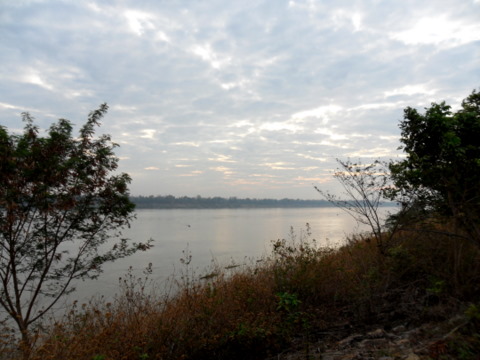
Dawn over the Mekong When I arrived at Somjit the bride’s home, the womenfolk in the family and neighbours were in the backyard preparing food in a communal kitchen set up in the backyard. 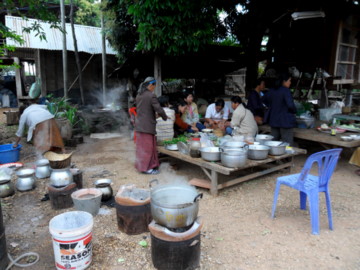
The communal kitchen Such is the community spirit in the village whenever there’s a special occasion. 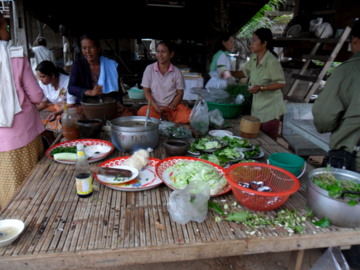
30 kg of pork and 30 kg of chicken were prepared here; note the size of the pots. 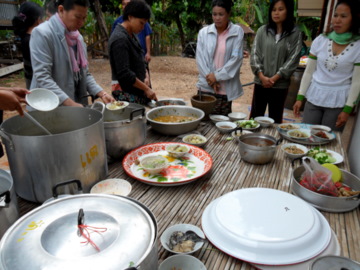
Sticky rice came in huge baskets. 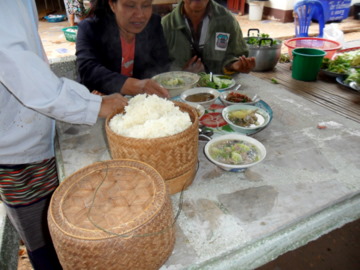
The men would organise the tents, tables, chairs and lighting in front of the home while the women prepared the food in the backyard. The women would somehow gather on one side while the men had their own corner. 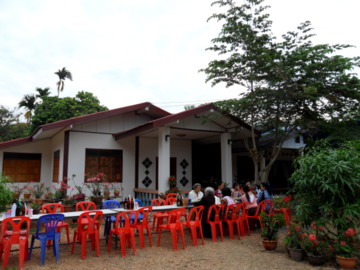
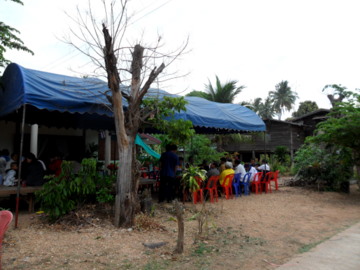
The wedding ceremony was held in the hall of the house and I was honoured to be the only non-family member present. Family members sat on the floor around the couple as the priest chanted prayers. Other guests sat and chatted outside the house. 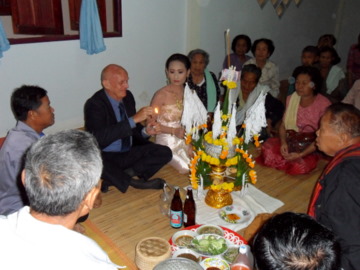
John prepares to light up The bride’s mother is the lady in red on the right in the photo below. 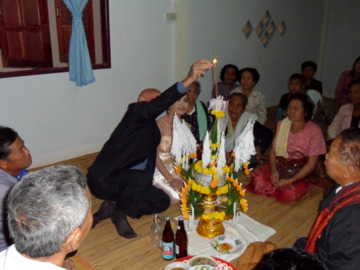
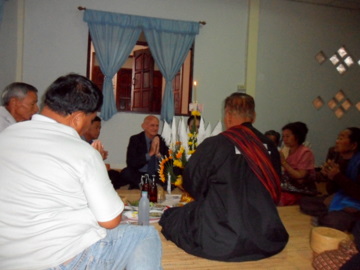
Chanting the prayers In Thai the dowry is often called the "cost of the mother’s milk", a token of appreciation to the mother for bringing up her child. 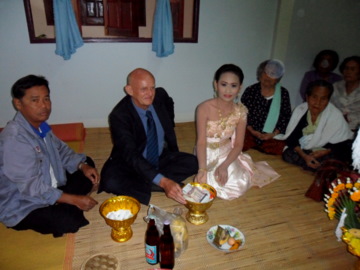
John offers the dowry to the bride’s mother. The dowry is also called the "price of throwing away one’s bachelorhood"! The amount depends on the qualifications and status of the bride. 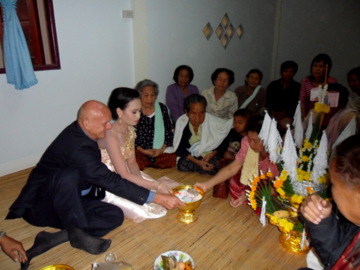
John and Somjit exchange gold rings after which John clips on the gold necklace for Somjit. 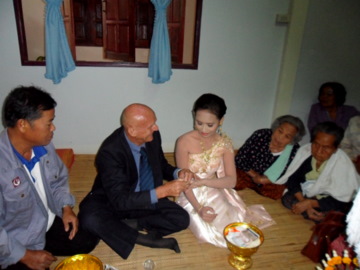
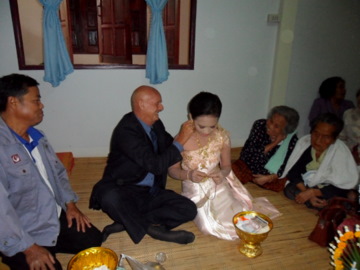
At the end of the wedding ceremony, family members tie white threads of good fortune on the wrists of the married couple and bless the newly-weds with prosperity. 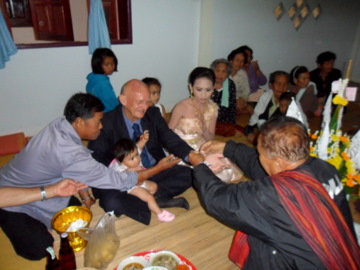
The priest takes the lead followed by other senior members of the family. Baht notes are also attached to the threads as gifts to the newly-weds. 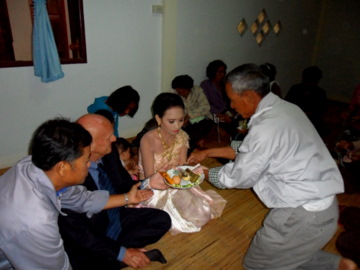
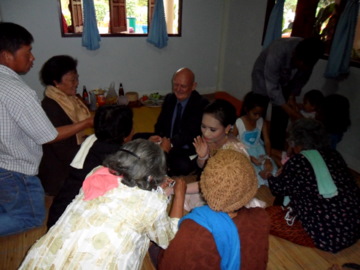
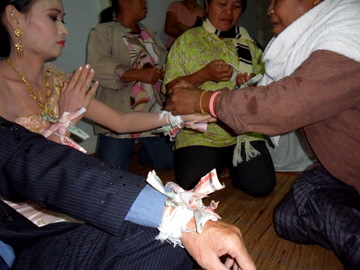
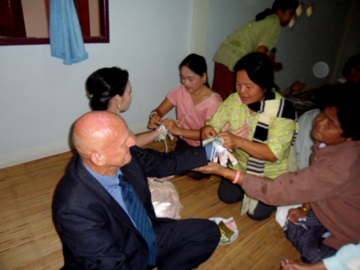
"Chains do not hold a marriage together. It is threads, hundreds of tiny threads which sew people together through the years." Simone Signoret After the formalities, family members sat in the hall of the house for a meal while neighbours ate outside. At the end of the party, some lingered on while others took their share of take away food and went home. Everything was over by 9:00 am! It was only then that I discovered that the main party the day before lasted till 3:00 am, that’s the part I missed as I was on route from Bangkok. Table of contents Scenes in Khemmarat This is the first time I’ve visited a village in Thailand. Ban Kaang Kliang in Khemmarat is memorable. After the wedding formalities, John and Somjit took me around to see some of the sights in Khemmarat. The village of Ban Kaang Kliang where Somjit’s family lives consists of about 200 households, most of whom are related. It’s a quiet village located on the banks of the Mekong. 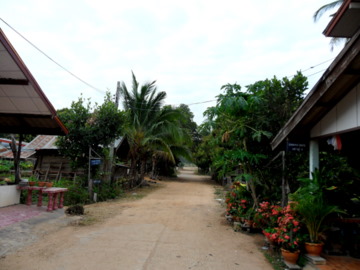
Ban Kaang Kliang The residents engage in cultivation or selling building material to the Lao villagers who come across the Mekong. 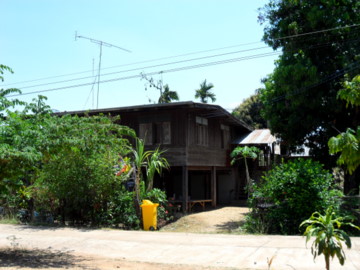
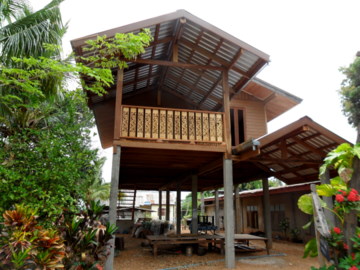
The space below the house serves an anti-flood measure, keeps wild animals away and is used as a general purpose area. Khemmarat town is a quiet little place about 9 km from Ban Kaang Kliang. There was hardly anyone in sight at six in the morning. 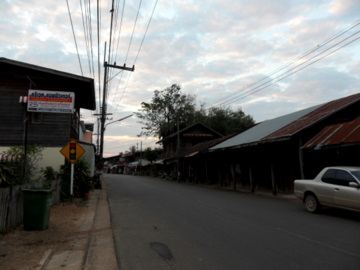
We also visited this temple known as Wat Phra To on the map but locally called Wat Ban Pak Saeng. It’s an old temple I was told and I noticed some old ruins on a mould of earth. They looked like the old pillars of a building that has been destroyed. 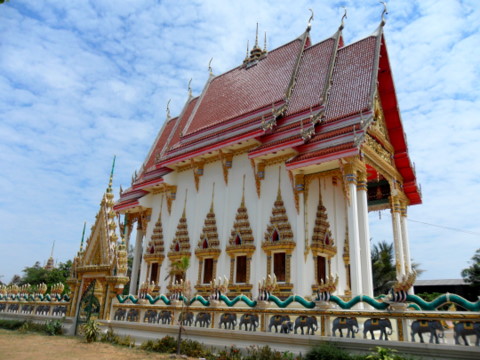
Notice the elephants in the wall, remember the Million Elephants? 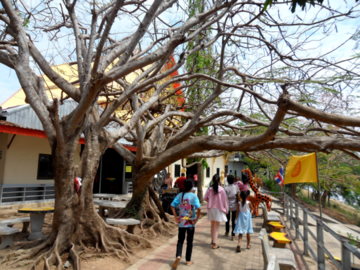
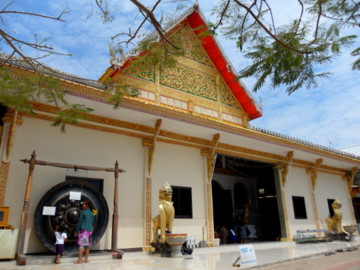
Very little is written about Wat Ban Pak Saang but it’s in a beautiful location, on the Mekong where you can look right across to Laos. 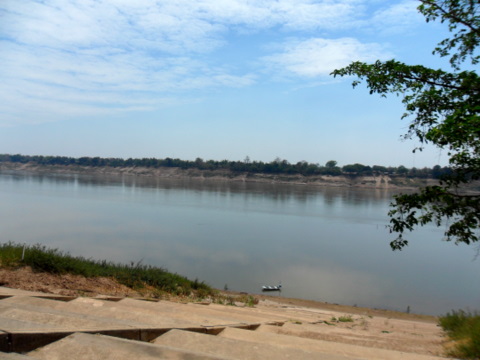
View of the Mekong and Laos from Wat Ban Pak Saang It’s so peaceful and scenic here. To think that a little over 30 years ago, US planes were bombing Laos and some of those planes were based in Ubon. How times have changed. As I stood on the banks of the Mekong and gazed across the placid waters to Laos and beyond, Bangkok seemed like another world away. Late afternoon on the same day, I boarded a bus for the 10 hour journey back to Bangkok and a very different world. 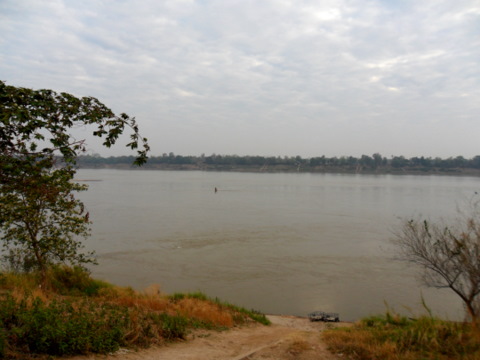
Memories of Khemmarat Table of contents Map to Khemarat View Khemmarat, Ubon Ratchathani in a larger map How to get to Khemmarat By public transport From the northern bus terminal at Mor Chit in Bangkok and take a tour bus to Khemmarat. Remember to take the bus that goes directly to Khemmarat, NOT to Ubon which is more than 100 km away from Khemmarat. The fare is 472 each way. The journey takes 10 hours. To amuse myself during such long trips, I’ve often compared the long bus ride to a flight. You get an on board movie, a stewardess serving a light snack of a bun or some cookies plus a bottle of water and a cold towel at the end of the journey! Have a nice trip. Travel advice – As Khemmarat is right on the Thai-Lao border there are frequent police checks. On both my forward and return trips, police boarded the bus and checked the identity papers of everyone on board. So please carry your passports with you. Table of contents My thanks I’d like to thank John and Somjit Forrest for their warm hospitality and for sharing this happy occasion in beautiful Khemmarat with me. I wish them a happy life together. 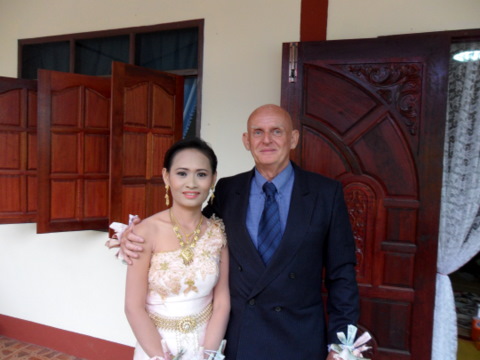
John and Somjit Forrest Table of contents Next month The Sanctuary of Truth, Pattaya 
If you enjoyed reading this e-zine, please forward it to a friend. If you received this from a friend and found it interesting, please subscribe at Bangkok Travelbug. What you think of the Bangkok Travelbug? We love to hear from you What other subscribers have said Till next month then. Eric Lim Find us on Facebook Stay updated with what’s new at Tour Bangkok Legacies. Copy the link below and paste it into your Google Reader, NetNewsWire or your favorite feed reader. https://www.tour-bangkok-legacies.com/tour-Bangkok-legacies.xml If you use My Yahoo! or My MSN, head over to my home page and click on the button for your favourite Web-based feed reader. Visit our home page at Tour Bangkok Legacies. Copyright@2008-2009 Tour Bangkok Legacies All rights reserved |
| Back to Back Issues Page |